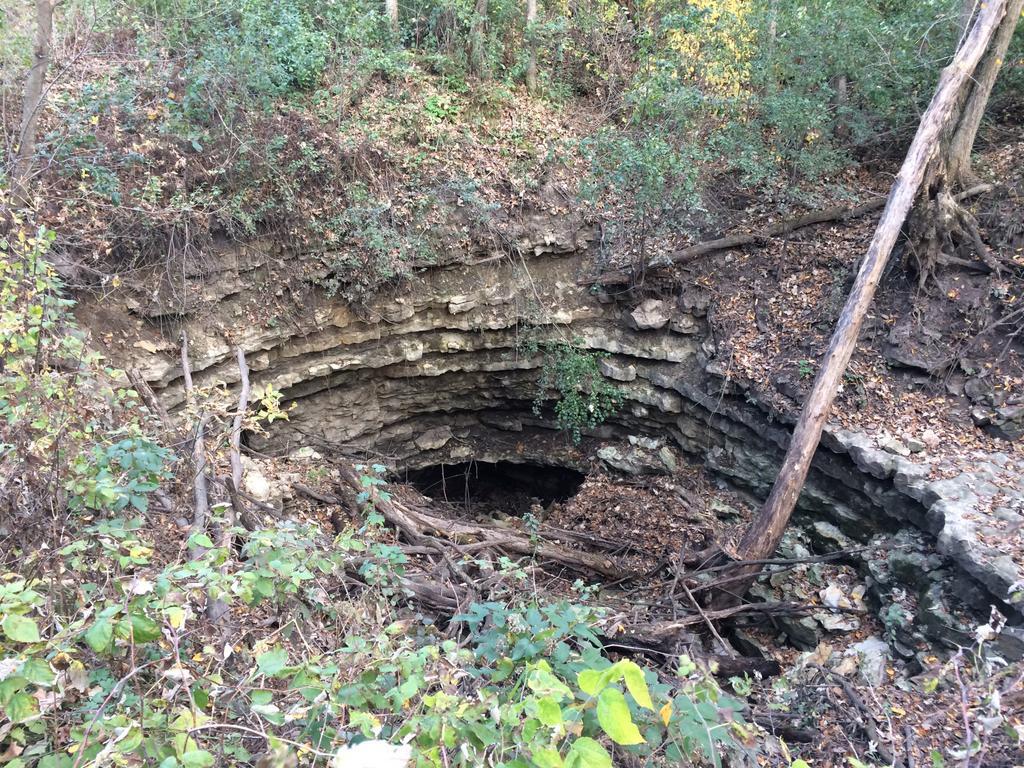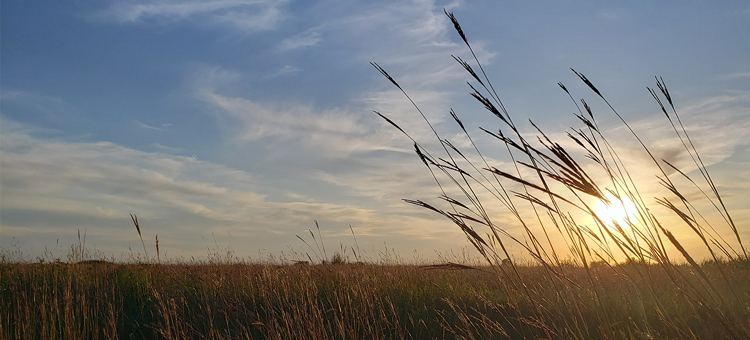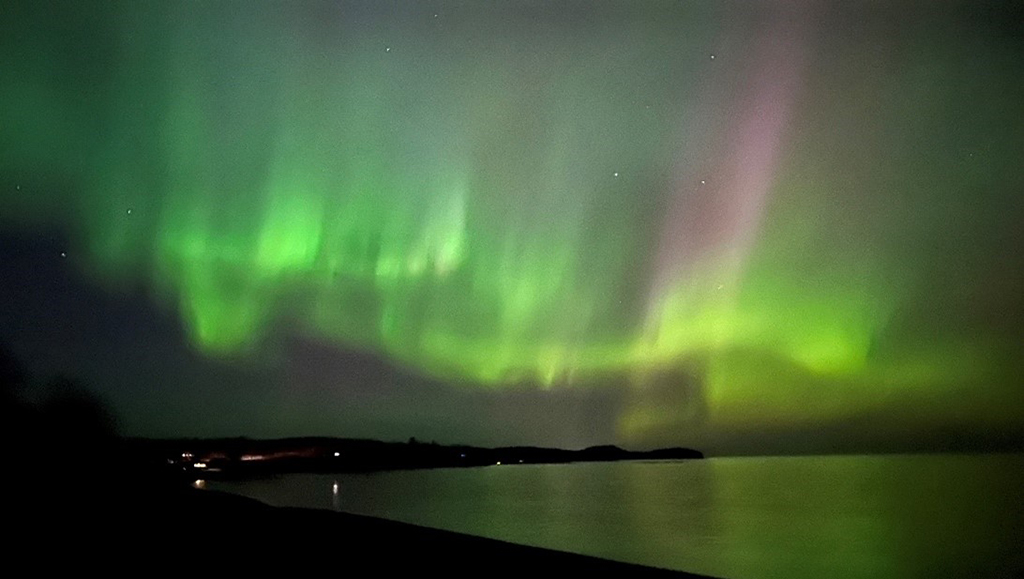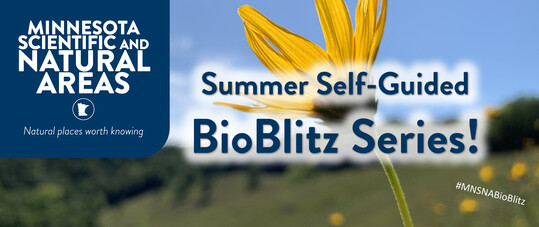
Site Highlight: Cherry Grove Blind Valley SNA
Laurie Allmann, with additional content by Matt Johnson, SNA Communications Outreach Specialist
|
Located in the southeast corner of Minnesota, Cherry Grove Blind Valley SNA is best known for Goliath Cave. The cave's natural entry is gated at the base of a well-like depression, walled by bands of limestone and shale. From this point, the multi-level, multi-branched cave system extends eastward far beyond the SNA boundaries.
 Goliath Cave entrance at Cherry Grove Blind Valley SNA. Photo by Laurie Allmann.
University of Minnesota researcher Calvin Alexander has extensively studied this cave system. According to Alexander, the portion of the cave within the SNA developed largely within the Dubuque Formation, while the rest of the cave (part of the adjacent, privately owned Karst Preserve) is associated with the older Stewartville Formation. These formations date to the Ordovician Period (443.7—488.3million years before present), when what is now Minnesota was located south of the equator and covered in shallow seas.
Cherry Grove Blind Valley SNA is known as a karst landscape, which are associated with southeastern Minnesota’s Driftless Area. Although glaciated earlier, this corner of the state was missed by the two most recent glacial advances. As a result, limestone and dolomite (dolostone) are found at or near the surface rather than buried under glacially deposited sediment. When water dissolves the carbonate minerals in this rock, channels and caverns are created.
Distinctive—even sculptural—geologic formations take shape as these minerals are re-deposited in the below-ground spaces. In Filmore County, these include dramatic flowstone formations, “soda straw” stalactites, rimstone dams, and rare, iron-cored speleothems, formations caused by the deposition of minerals from water over time. Such caves also offer specialized habitat for bats and other forms of life, including a species of springtails (relatives of snow fleas) that lack pigment and eyes. Groundwater in Karst landscapes is highly sensitive to pollution from surface contaminants.
Sinkholes, blind valleys, karst windows and springs are found on the land surface above underground karst systems and are thought of as surface expressions of karst or "karst topography." However, karst also occurs in areas with few or none of these land surface features and therefore the absence of these features does not imply the absence of karst.
To appreciate the big picture, plan a road trip connecting the dots, as suggested by former Forestville State Park interpretive naturalist Bob Storlie. Begin at the SNA to see the blind valley, sinkholes and cave entrance. Then drive the five miles to Forestville State Park for a guided tour of Mystery Cave which—like Goliath Cave—developed in carbonate rocks of the Stewartville and Dubuque Formations. Portions of Mystery Cave developed in carbonate rocks of the Maquoketa Formation of the Ordovician Era. Finally, hike to "Big Spring," where Goliath's waters gush from the base of a cliff into Canfield Creek. Dip your fingers in the icy water. If you're lucky, you'll see a leaping trout. Perfect.
Back to top

Staff Highlight: Judy Schulte
I have been with SNA for 12 years. I started with SNA in 2011 as the Southwest Regional Prairie Specialist, in 2015 I become the Statewide SNA Prairie Biologist and in December of 2022 I became the SNA Unit Supervisor.
As the Statewide SNA Supervisor, it is my job to work with staff, department and state leaders, non-profits, and citizens to support and advance SNA’s development, implementation, and evolution. This includes directing the development and delivery of policies and strategies to increase the effectiveness of the program, coordinating the development and implementation of program work plans in order to achieve objectives, directing and managing fiscal resources, and promoting teamwork and collaboration among internal and external staff and partners.
 Judy Schulte. Photo by Rhett Johnson
What is the best part about your job (and why)?
Obviously, building a career around protecting the state’s rarest plants and animals is pretty darn cool! In addition to that, what keeps me energized every day are the amazing people I work with here at the DNR. If you ask me, SNA has the kindest, hardest working, dedicated staff that I feel very privileged to work with and support every day.
Why do you do this work?
I am the third generation to live on my family’s farm and my two sons are now the fourth. Being a good steward of land in order to pass it onto the next generation is something that was instilled in me from early on. In addition to typical farm operations (row crop), my family also raised wild game (elk, deer, bison, fallow deer, variety of birds, etc.). Unlike most young girls my age who received a new doll or the latest trend toy for their birthdays, I received duck cages, ponds, or whatever else was needed for my latest wildlife adventure. My family vacations were spent exploring state and national parks. Ultimately, I decided to make my advocation my vocation and spend my career exploring and managing Minnesota’s best natural features and helping landowners protect the hidden gems on their properties.
What gets you excited about your work?
I am a natural problem solver and am energized when I see opportunities to do things more effectively and efficiently. Not everyone gets the privilege to work every day to protect the state’s rarest natural features so if I can remove even one hurdle to help us manage these resources better, that’s a good day!
What are the challenges of this line of work?
So much about conservation work is out of our control and all we can do is our best to move the needle on what we can control or influence for the better. Sometimes that means years of advocation for truly viable solutions and many, many hurdles to cross along the way. Persistence and hard work are the necessities for success.
What is your favorite way to spend time outdoors (and why)?
I enjoy the outdoors in pretty much every way I can and really believe in the mental and physical benefits of time spent outdoors. Hiking, camping, running, fishing, kayaking, mushroom hunting, horseback riding, gardening, golfing, etc. you name it, I enjoy it all. I have two sons (11 and 6 years old) and our goal is to visit all of the state parks and as many SNAs as we can before they graduate.
What is your favorite native Minnesota plant or animal?
This is a tough question, there are so many to pick from. I would say the short-eared owl because it is an iconic prairie species and having spent my entire life on the prairie, there is just always something special about seeing a short-eared owl flying over a prairie.
What is your favorite SNA?
Can I pick Native Prairie Banks? Minnesota is the only state natural areas program to have a conservation easement program. Native Prairie Bank conservation easements are used to protect privately owned high quality native prairie across the state and SNA staff team up with the landowners to manage their prairies for the benefit of everyone. Our privately owned native prairie banks in the Minnesota River Valley are hidden gems I feel lucky to be a part of the management of.
What do you like to do outside of work?
My two amazing sons keep me busy outside of work plus I have a wonderful family and more great friends than any one person deserves. I enjoy anything tied to cooking (grilling, smoking, canning, etc.), spending time with friends, coaching hockey, hiking, camping, running, fishing, kayaking, mushroom hunting, horseback riding, gardening, golfing, etc.
Is there anything else you’d like to share?
I feel honored to be chosen for this new role within SNA and am thankful for the last 12 years working for the SNA program. I can’t promise I will do everything perfect or improve all the things that need improvement, but I can promise I will work hard every day for the betterment of SNA.
Back to top
Minnesota Prairie
Discover Minnesota prairie with extensive information on web pages dedicated to all things prairie! If you’ve ever wondered what makes prairie special, where to go to visit one, or why prairie is important, these are the web pages for you!
 Back to top
Notes from Site Stewards
Site stewards monitor SNAs across Minnesota. Their observations provide valuable information to the SNA Program. Eager stewards were ready for spring to get out and make some observations!
- At Iona’s Beach SNA, site steward David Glaser visited May 23rd and was treated to amazing views of the northern lights that evening. In addition, the SNA was in pristine condition.
-
Tony Ernst, trekked into Savage Fen SNA on May 24th and reported there was “lots of small plants blooming, including many Small White Lady's-slippers and Small Yellow Lady's-slippers.”
- On June 3, Marsha Kurka, site steward at Boot Lake SNA, reported making observations of over 42 bird species by using the sound portion of the Merlin Bird ID app. She noted plentiful wood ducks and goslings enjoying the wonderful.
-
Tom Rice site steward at Chamberlain Woods SNA along with stewards from neighboring SNAs searched for dame’s rocket throughout the spring even though some of its known locations were “in the midst of a tangle of prickly ash, briars and deadfall.” Thanks for your hard work, Tom and friends!
 Iona’s Beach SNA with Northern Lights over Lake Superior. Photo by David Glaser
Back to top

SNA Events
Are you interested in visiting an SNA this summer? There are a variety of events scheduled for the coming months. To find one you might be interested in, visit the SNA events calendar.

06/24/23 June Stewardship Project Lost Valley Prairie SNA
07/08/23 B.Y.O.K. (Bring Your Own Kayak) Bog Paddle Lost Lake Peatland SNA
07/10/23 - 07/24/23 Self-guided BioBlitz Badoura Jack Pine Woodland SNA
07/12/23 Wednesday in the Wild Blanket Flower Prairie SNA
07/14/23 Friday Night Hikes on Bluestem Prairie Buffalo River State Park
07/22/23 July Stewardship Project Lost Valley Prairie SNA
07/28/23 Friday Night Hikes on Bluestem Prairie Buffalo River State Park
07/29/23 Volunteer Stewardship Project: Queen Anne's Lace Removal Osmundson Prairie SNA
08/14/23 - 08/28/23 Self-guided BioBlitz Compass Prairie SNA
|